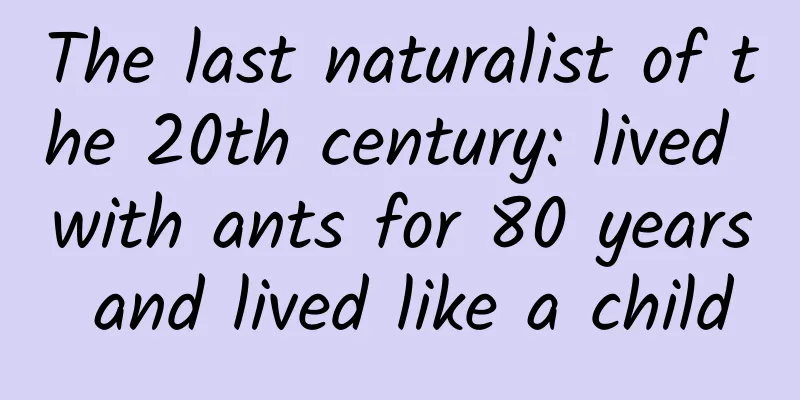The last naturalist of the 20th century: lived with ants for 80 years and lived like a child

|
2Author: Hu Minqi On December 26, 2021, Edward Wilson, "the last naturalist of the 20th century", passed away at the age of 92. Wilson's research career began with ants and he never left it throughout his life, spanning more than 80 years. In 2020, Wilson, who was already 91 years old, published his last work, "The World of Ants". As if aware of the end of his life, Wilson devoted time to the love of his life. He carefully selected 26 stories about ants and also condensed important fragments of his own life into them. Recently, the Chinese version of Wilson's posthumous work was officially released. Wilson's 13th year In recent years, domestic news media have repeatedly reported on an extremely aggressive invasive species - the red fire ant, which not only seriously affects agricultural production and destroys the local ecology, but also bites humans and animals, causing the latter to have severe allergic reactions. According to monitoring by relevant departments, red fire ants have spread to 48 county-level administrative units in 12 provinces in the country, making it difficult to "encircle and suppress" them. Wilson was one of the first people in North America to recognize the invasion of fire ants in the early 20th century, when he was 13. The invasion was perhaps the most important discovery of Wilson's youth. In 1942, he found an anthill about 30 centimeters high in a dug field in Mobile, USA, which was full of ants he had never seen before. It turned out that they were invasive red fire ants. For the entire history of the United States, the red fire ant has been a fateful species. In the 1950s, the invasive fire ant spread across the United States. At the time, the U.S. Department of Agriculture and chemical companies planned to eliminate them through large-scale spraying of pesticides. Wilson, who has become an ant expert, is very opposed to this because according to scientists' research, traditional methods not only fail to kill red fire ants, but also expose other organisms and humans in the pesticide treatment area to danger. However, Wilson failed to stop the plan, and the result was that the fire ants landed again in Hawaii, and then established beachheads in Australia, New Zealand, and China, becoming a truly international problem. Because of ants, Wilson participated in and witnessed a piece of environmental history, which is also one of the 26 stories in "The World of Ants". Wilson wrote more than 30 books in his lifetime, most of which were academic. He admits that it was not until this book that he presented antology as a physical and intellectual adventure in the form of storytelling. The stories of these ants are not only related to scientific discoveries, but also include Wilson's life experiences in different time periods. "This book has a strong sense of personal memoir, and his whole life seems to be condensed in these stories," said Ran Hao, a popular science writer and one of the translators of the book. Wilson is well aware of the public's tastes and interests, and uses a writing style that combines scientific knowledge with life stories to ensure the best reading experience of this book. "He has the mind of a top scientist and the writing style of a mature writer." Ran Hao commented that the perfect combination of the two abilities makes Wilson a very rare figure among popular science writers. Why Ants? Wilson discovered about 450 species of ants in his lifetime, almost standing at the top of the pyramid of ant taxonomy. But what really made Wilson famous was that in his dedicated research on ants, he organically integrated population biology, animal behavior and evolutionary theory, and created an important branch of biology, "sociobiology." Ran Hao introduced that in today's field of sociobiology, ants are very typical model organisms, and there are the most fascinating stories here. These stories also constitute the most exciting part of this book. Ant society is almost a "female" world, where female ants have complete dominance. All ants that are busy working, exploring the external environment or participating in wars (all-out ant wars) are females. Compared with female ants, male ants are particularly pitiful. Their only purpose in their lives is to mate with virgin queens in other ant colonies during their nuptial flights. Wilson describes the male ants as a swarm of flying "sperm missiles." Once the "missile" is launched, regardless of whether it is successful or not, it will be abandoned by the ant colony and die in the next few hours or at most a few days due to rain, high temperature or the claws of predators. What's horrifying is that many ant species will eat their own if they are injured or dead. Old or disabled worker ants will leave the nest according to established guidelines and will not cause any burden to the ant colony. Ants that die in the nest are discarded where they are, while severely injured or dying ants are eaten directly by their sisters. Wilson discovered that ants are the most warlike of all animals, and the struggle between different ant colonies of the same species is the most intense, usually with the goal of eradicating the roots. He had seen battlefields littered with corpses of "warriors" and discovered that most of them were old female ants. As adult worker ants age, they perform increasingly dangerous tasks for the benefit of the colony. Because "for ants, serving the colony is everything. When natural death is approaching, it is more beneficial for the colony for old worker ants to engage in dangerous activities in their last days." In Wilson's view, ants have reaped rich rewards by using these social organization strategies that are beyond human imagination. So far, more than 15,000 species of ants have been discovered, named and studied in detail, equivalent to the number of bird and mammal species combined. The total weight of ants on Earth is roughly equivalent to the weight of all human beings. Ants have infiltrated every corner of terrestrial ecosystems except in high-altitude areas. They dominate terrestrial carnivores weighing 1 to 100 mg and are truly “small organisms that make the world go round”, at least among terrestrial animals. Someone once asked Wilson, "Why study ants?" He replied, "Ants are so interesting, why doesn't everyone study them?" He "traveled back to the forest 100 million years ago as he wished" "Every child has a period of time when he loves insects, and I have never grown out of it." Until the end of his life, Wilson never lost his strong curiosity about the natural world. In this sense, he lived like a child all his life. When he was in elementary school, he collected all kinds of insects he could see around his neighbors' homes and on the streets where he attended elementary school. For him as a child, this was an exciting adventure. When he grew up, this expedition became an important data collection work in modern ecology - cataloging the biodiversity of all species, which is also his unfinished business. This experience made Wilson very hopeful that the book would appeal to students who were interested in pursuing a career in science. In his opinion, it was not too early to cultivate such an interest even at the age of ten. It was at this age that Ran Hao became interested in ants. At that time, he could see ants and ant nests everywhere. He observed the worker ants, larvae and eggs in them, and watched ants moving and fighting. This hobby lasted for nearly 30 years until he became a die-hard ant fan, researcher, and a popular science author who won the Wenjin Book Award. But children today are different from those in the past. In the environment they live in, the species and number of insects are decreasing. In Ran Hao's opinion, what is more worrying is that "people don't realize how abnormal it is to have an environment with plants but no insects." "There is a mutually dependent co-evolutionary relationship between angiosperms and insects. Plants provide for insects, and insects help them sow and reproduce. Therefore, angiosperms and insects complement each other." Ran Hao explained that the importance of an organism in an ecosystem is not determined by its size, but insects are difficult to attract people's attention because of their appearance. Reading "The World of Ants" helps change people's cognition. In the last chapter of the book, Wilson tells the story of the evolution of the ancestors of ants, including a type of predatory ants with large jaws that have attracted much attention in recent Burmese amber research - Hades ants, which lived about 100 million years ago. Wilson asked himself, if magic allowed him to travel to any time and any place in Earth's history for a few hours, which era and place on Earth he would choose to go to. His answer: a Mesozoic forest 100 million years ago filled with ants (including Hades ants). "Maybe the old man didn't leave, but traveled back to the forest 100 million years ago as he wished." This is Ran Hao's most sincere blessing to his idol. China Science Daily (2022-02-25, 3rd edition) Editor | Zhao Lu Typesetting | Guo Gang |
>>: Scientists let 10,000 worms share a pizza. The reason behind this is heartwarming?
Recommend
This dirty thing is only available in rural areas, but it is very useful
The theory of traditional Chinese medicine emphas...
Diet therapy of Jerusalem artichoke, one of the traditional Chinese medicines for clearing heat and cooling blood
We know that Jerusalem artichokes are actually wh...
If you don’t change these habits, osteoporosis may occur earlier! See if you are affected...
Many people think Osteoporosis is a problem only ...
The efficacy and function of Huoxuelian
Traditional Chinese medicine has a history of tho...
Is it okay to take Chinese medicine half an hour after a meal?
Traditional Chinese Medicine is my country's ...
What are the effects and functions of Trichosanthes seed?
Trichosanthes seed has great medicinal value, but...
The efficacy and function of millet firewood
As a traditional Chinese medicine, do you know th...
Lycopene capsules
Lycopene is a natural pigment found in the foods ...
The efficacy and function of Black Dragon tendon
Do you know what Black Dragon Tendon is? If you k...
Is eating animal organs harmful to health? Can you eat them safely? Today I will tell you the truth...
This article was reviewed by Pa Li Ze, chief phys...
Spring is the right time to lose weight, but how can you effectively reduce excess fat in your body?
With the end of winter, many people are planning ...
Another ancient fish fossil was discovered in Chongqing, you are still too comprehensive!
Produced by: Science Popularization China Author:...
Centella asiatica cream ointment
There are many common diseases in life, and skin ...









